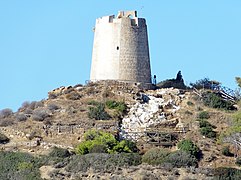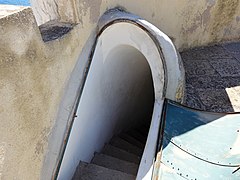Torre di Chia
| Torre di Chia | ||
|---|---|---|
|
North side of the Torre di Chia |
||
| Alternative name (s): | I Santi de Quaranta de Quia | |
| Creation time : | 1578-1592 | |
| Conservation status: | essential parts received | |
| Construction: | Limestone - masonry | |
| Place: | Chia , Domus de Maria | |
| Geographical location | 38 ° 53 '43.2 " N , 8 ° 53' 5.8" E | |
| Height: | 45 m slm | |
|
|
||
Torre di Chia ('Tower of Chia') is a guard and defense tower from the 16th century on the south coast of the Italian island of Sardinia . It belongs to a system of 102 so-called Saracen towers that were supposed to protect Sardinia from pirate attacks from the barbarian states . The Torre di Chia is located in the municipality of Domus de Maria on the Costa del Sud .
location
The Torre di Chia stands on a promontory between the beaches of Su Portu (Spiaggia Su Portu) and Sa Colonia (Spiaggia della Colonia) . At Su Portu, the Riu di Chia flows into the Mediterranean, a small river or stream that irrigates the plain of the Chia settlement. Today, Chia is a holiday resort within the municipality of Domus de Maria with hotels and a campsite below the Torre di Chia . The two beaches mentioned are partially managed (rental of sun beds and umbrellas).
History and description
The hill on which the Torre di Chia stands formed the ancient acropolis of Bithia , one in the last quarter of the 8th century or in the 7th century BC. Phoenician settlement founded in BC . It existed as an inhabited coastal town from the Punic and Roman times until the beginning of the 5th century AD. Northeast below the tower, archaeological excavations are taking place, which are covered outside of the excavation campaigns .
The remains of Bithia served the construction of the Torre di Chia , consisting of limestone - Masonry is and on a schedule of Marco Antonio Camos, the Capitano of Iglesias back, from the year 1572nd The Kingdom of Sardinia made at that time one of a viceroy managed by-country the Spanish crown under Philip II. After the Conquest of Tunis by his father Charles I (1535) and the unsuccessful naval expedition to Algiers (1541) it was decided the coasts of Sardinia against the to secure constant pirate attacks from the barbarian states from the sea with towers.

The construction of the Torre di Chia began in the time of the Viceroy Miguel de Moncada from 1578, it was completed by the end of 1592 and from 1594 the tower was used under the name I Santi de Quaranta de Quia . The building was of the so-called torre de armas type , a tower permanently equipped with cannons. Decisive for the location was the mouth of the Riu di Chia northeast below the foothills, which provided the barbaric pirates with a fresh water supply until the tower was built.
The Torre di Chia was manned by a commander, a gunner and three soldiers. In addition, two mobile soldiers were deployed outside the tower. The three cannons on the gun platform were 6-pounders and 8-pounders (caliber about 90 and 100 mm). The Torre di Chia was repaired several times (1605, 1614, 1769, 1784, 1808, 1818, 1840), in 1614 after it was destroyed, probably by fire after an attack. After the tower was no longer used for coastal defense, it was used by the Guardia di Finanza to fight smuggling until the 1950s .
The conical rotunda of the Torre di Chia , which was restored in 1988 and the beginning of the 1990s, is around 13 meters high and over 10 meters in diameter. The wall thickness is approximately 2.5 meters. Today the tower can be entered via a staircase to the entrance 5 meters above the ground on the west side. The access leads to the first floor, which has a vaulted ceiling and is supported by a massive central column. From there a stone spiral staircase runs to the gun platform. Cannons are no longer on the tower. The interior and the gun platform can be viewed for a fee of three euros (2017).
- Views of the tower
Individual evidence
- ↑ a b c Mauro Salis: Pula and surroundings . Patrimonio culturale Sardegna, Cagliari 2011, p. 37-41 .
- ^ Hans-Georg Niemeyer : Bitia. In: The new Pauly (DNP). Volume 2, Metzler, Stuttgart 1997, ISBN 3-476-01472-X , Sp. 703.
- ↑ a b c Domus de Maria, Torre di Chia. Regione Autonoma della Sardegna, 2017, accessed October 2, 2017 (Italian).
- ↑ Francesco Cesare Casula: The History of Sardinia . Carlo Delfino editore, Sassari 2000, ISBN 978-88-7138-325-5 , p. 38 .






